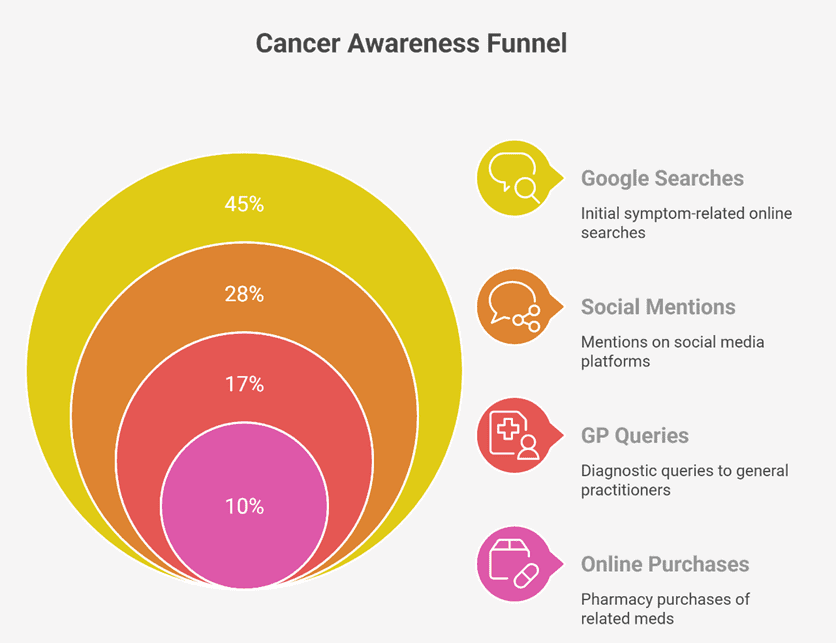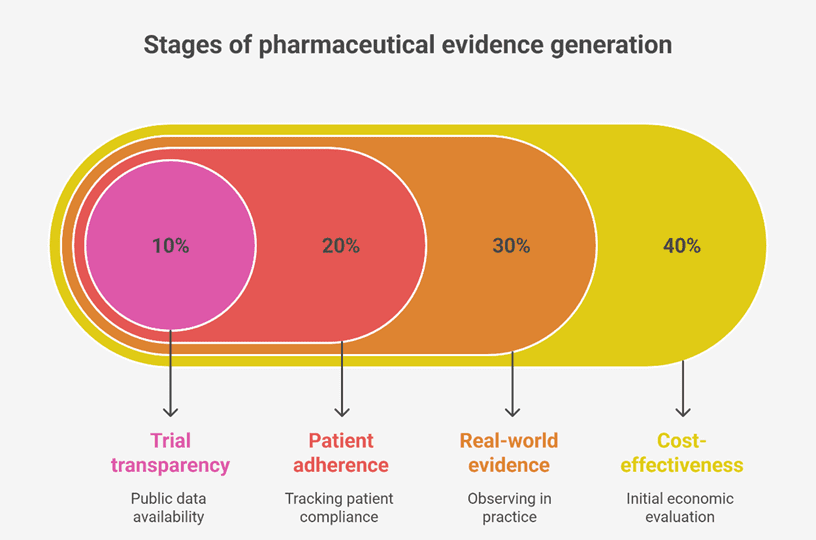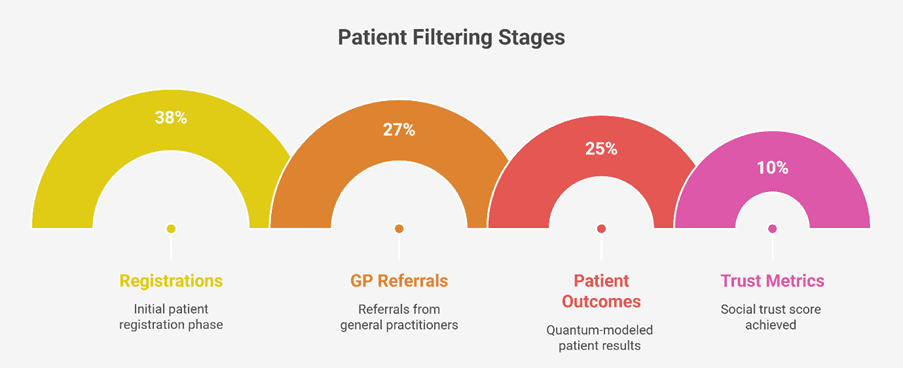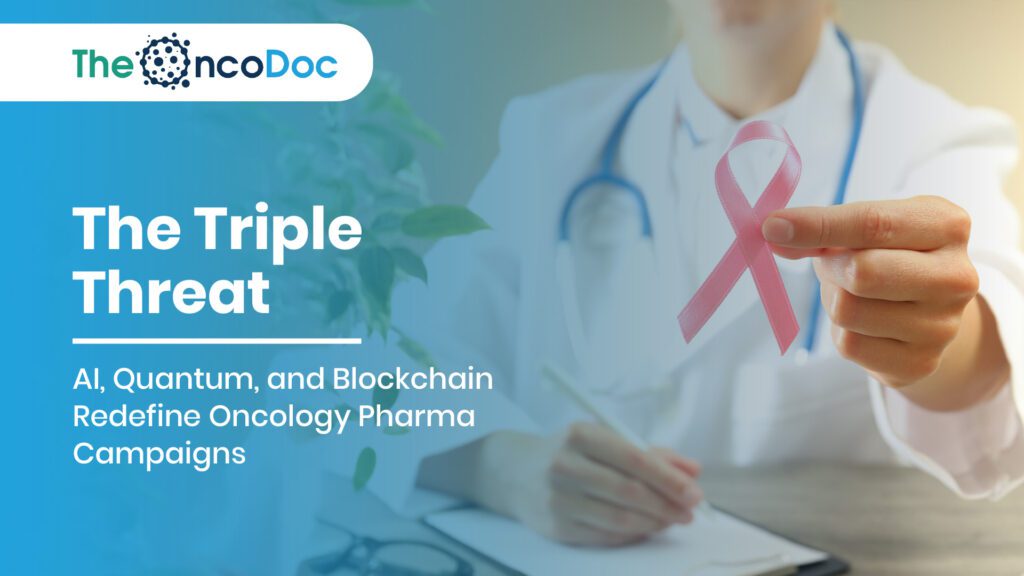Introduction: A Convergence That Changes Everything
Oncology pharma marketing is no longer defined by one disruptive technology, it now thrives at the intersection of three: Artificial Intelligence (AI), quantum computing, and blockchain. This triple threat is not just a buzzword but a practical framework transforming how campaigns are designed, validated, and trusted.
In oncology, where decisions can determine survival, timely awareness, data-backed insights, and credibility are non-negotiable. AI brings intelligence through pattern recognition and personalization, quantum delivers unmatched computational power to handle the complexity of cancer biology and patient data, while blockchain guarantees transparency and trustworthiness in every transaction or communication.
Together, these technologies don’t just enhance pharma marketing; they redefine its purpose, moving from persuasion toward empowerment, building systems where oncologists, patients, caregivers, and payers operate with clarity, confidence, and collaboration. This article highlights four foundational pillars that illustrate how this convergence reshapes oncology campaigns.
1. AI-Enhanced Patient Segmentation
Traditional segmentation models categorized patients broadly by demographics, age, or geography. But cancer is not a generic disease, it is highly individual, influenced by genetic markers, lifestyle choices, and environmental exposures. AI transforms segmentation by integrating these multidimensional datasets.
- Detection of micro-segments: For example, AI can identify smokers with a specific genetic mutation who are at heightened risk for lung cancer. This allows pharma to craft campaigns that are more precise than one-size-fits-all awareness drives.
- Personalized awareness journeys: Instead of generic ads, AI tailors communication, urban women aged 40–50 may receive mammogram reminders, while rural populations may see oral cancer education content in local dialects.
- Improved ROI: By eliminating wasted impressions and targeting those most likely to act, AI maximizes efficiency in awareness and engagement campaigns.
The result? Campaigns that feel less like marketing and more like guidance, reaching the right people with the right message at the right time.
2. Quantum-Driven Predictive Modeling
If AI personalizes today’s campaigns, quantum computing sets the stage for tomorrow’s foresight. Oncology is a field of complexity, genetic, biological, and behavioral factors interact in ways that classical computing struggles to simulate. Quantum steps in to model millions of overlapping cancer scenarios almost instantly.
- Comprehensive risk modeling: Quantum computing can analyze how environmental exposure (like air pollution), lifestyle factors (such as diet), and genetic predispositions intersect to influence cancer risk.
- Optimized campaign timing: By simulating patient journeys, quantum helps identify when individuals are most receptive to screenings or consultations, ensuring campaigns hit at pivotal moments.
- Faster adoption of treatments: With predictive modeling, delays between symptom recognition, diagnosis, and treatment initiation can be significantly reduced.
This predictive power shifts oncology marketing from reactive to proactive, allowing campaigns to act as early intervention tools rather than after-the-fact awareness efforts.
3. Blockchain for Transparent Trial Communication
Clinical trials are the backbone of oncology drug development, but skepticism often arises from data opacity and lack of accessibility. Patients and oncologists need to know that the results they’re being presented with are genuine, untampered, and transparent. This is where blockchain becomes transformative.
- Immutable consent records: Patients participating in oncology trials can be assured their consent and medical records are permanently secured, reducing ethical concerns.
- Transparent data sharing: Blockchain allows oncologists, researchers, and even patients to access verified trial results, increasing trust in claims used during marketing campaigns.
- Credibility in communication: When pharma references trial data in campaigns, blockchain-backed authenticity ensures that the figures are unaltered and reliable.
In a field where trust is currency, blockchain strengthens the credibility of pharma’s voice and helps dissolve doubts surrounding new therapies.
4. The Shift from Awareness to Trust-Building
Oncology marketing has long emphasized awareness, symptom recognition, screening reminders, survivor stories. While still vital, awareness alone is no longer enough. Patients and caregivers demand trustworthy, validated information before making life-altering decisions.
Here, blockchain plays a central role. Every statistic, every claim, and every testimonial included in a campaign can be backed by an unalterable verification trail. This ensures patients know they are not just reading persuasive content but engaging with authentic, validated insights.
- Combating misinformation: Blockchain’s ability to authenticate sources helps reduce the spread of harmful myths about cancer cures.
- Enhancing credibility: Survivor testimonies, once prone to skepticism, gain weight when their origin and authenticity are verified.
- Building stronger relationships: Trust-based communication ensures oncology campaigns resonate not only emotionally but also intellectually with patients and doctors alike.
The transition is clear: pharma marketing in oncology must evolve from being awareness-centric to trust-centric, creating campaigns that don’t just inform but reassure.
5. AI-Powered Content Personalization
AI is redefining how oncology messages reach patients, caregivers, and doctors. Instead of generic communication, AI matches individual search behavior, digital footprints, and clinical history with tailored educational content.
- Targeted video ads: A patient searching for “persistent cough” may receive a video on lung cancer warning signs.
- Multilingual chatbots: In rural areas, AI-driven bots converse in local dialects, answering questions with empathy and accuracy.
- Adaptive landing pages: Oncologists may see detailed efficacy data, while caregivers are guided with emotional support resources.
This personalization makes campaigns feel relevant, human, and supportive, increasing both engagement and trust.
6. Quantum-Accelerated Drug Value Demonstrations
Convincing oncologists about a drug’s value requires more than brochures. Quantum simulations now allow marketers to present science in real time.
- Interactive tumor models: Doctors can see exactly how a molecule interacts with cancer cells.
- Combination predictions: Quantum tools forecast how therapies may work together for complex cases.
- Evidence-based storytelling: Instead of claims, pharma delivers data-driven visual narratives.
This empowers oncologists with confidence in treatment decisions while elevating pharma’s credibility.
7. Blockchain-Secured Survivor Stories
Survivor-led narratives inspire hope, but authenticity is key. Blockchain safeguards these stories by:
- Verifying testimony origins.
- Preventing manipulation or data misuse.
- Enhancing community trust in emotional campaigns.
Patients and caregivers engage more when they know the story is real and untampered.
8. Omnichannel Precision Marketing
AI ensures consistency across multiple touchpoints:
- Survivor reels on Instagram.
- CME learning modules via WhatsApp.
- Personalized oncology updates through email.
When backed by blockchain validation, this omnichannel approach creates seamless, trustworthy engagement across audiences.
9. Predictive AI for Regional Campaigns
By analyzing digital chatter, AI predicts where cancer incidence will rise. Pharma can then launch micro-campaigns in real time.

10. Quantum-Powered Clinical Insights for Oncologists
Oncologists are inundated with vast streams of new research, trial data, and treatment protocols. Quantum computing brings clarity by compressing this ocean of data into actionable insights.
- Curated research insights: Instead of scanning thousands of papers, oncologists receive distilled, AI + quantum-curated summaries, highlighting the most relevant evidence for their patient populations.
- Real-time treatment guidance: By integrating genetic, diagnostic, and treatment history, quantum algorithms suggest evidence-backed therapy options within seconds.
- Visual dashboards: Pharma-sponsored platforms can present interactive dashboards powered by quantum outputs, helping oncologists compare drug efficacy, side-effect probabilities, and patient outcomes.
This shift empowers oncologists to make faster, data-rich decisions while positioning pharma brands as enablers of knowledge, not just suppliers of medication.
11. Blockchain-Based Consent in Patient Communities
Digital oncology forums are becoming essential spaces for support and knowledge sharing, but privacy remains a concern. Blockchain ensures these communities remain secure and transparent.
- Verified consent: Patients decide how their data is shared, with blockchain providing immutable consent trails.
- Clear engagement audits: Every interaction, whether sharing medical data or joining a trial, is securely logged.
- Trust in pharma-led spaces: Patients and caregivers feel more confident participating in communities supported by pharma when authenticity and transparency are guaranteed.
By creating a safe digital ecosystem, blockchain strengthens long-term patient engagement.
12. Behavioral Nudges, Powered by AI
Cancer awareness campaigns often struggle to convert intention into action. AI, when combined with behavioral science, bridges this gap through subtle yet effective nudges.
- Timely reminders: Personalized notifications prompt women at higher risk to schedule mammograms during awareness months.
- Gamified health quizzes: Interactive self-check tools transform screening from a chore into an engaging experience.
- Voice-driven nudges: AI-powered assistants in regional languages encourage rural populations to attend nearby screening camps.
These nudges reduce inertia and increase early diagnosis rates, transforming awareness into measurable impact.
13. Survivor-Led Quantum Simulations
Survivor stories are among the most authentic and persuasive tools in oncology marketing. When combined with quantum-powered simulations, they evolve into evidence-driven emotional storytelling.
- Empathy-driven narratives: Survivors explain their journeys in relatable terms, breaking fear and stigma.
- Evidence-backed visuals: Quantum models visually demonstrate how early intervention changed outcomes, showing tumors shrinking or drugs halting progression.
- High-engagement campaigns: These powerful, science-meets-emotion campaigns drive both awareness and trust among patients and caregivers.
The result is a fusion of hope and science, where survivors not only inspire but also educate with credibility.
14. Blockchain-Verified CME Modules for GPs
General practitioners (GPs) remain the frontline in early detection, yet continuous education is crucial to improve referral accuracy. Blockchain enhances the credibility and reliability of pharma-led CME initiatives.
- Authentic certification: CME completion certificates are stored on blockchain, eliminating concerns of forgery or duplicate credentials.
- Compliance checks: Blockchain ensures pharma-sponsored CME content follows strict medical and ethical guidelines.
- Trust in education: GPs engage more actively when they know learning platforms are transparent, verified, and free from manipulation.
This creates trusted knowledge pipelines, empowering GPs to confidently identify symptoms, make timely referrals, and collaborate with oncologists.
15. Emotional Storytelling Meets Data Integrity
In oncology, emotion drives action, but credibility sustains trust. AI pinpoints the emotional triggers that resonate with patients and caregivers. Quantum computing validates treatment outcomes, ensuring stories are grounded in scientific accuracy. Blockchain secures authenticity, verifying that survivor narratives and clinical claims remain untampered. Together, these technologies create campaigns that inspire hope while preserving integrity, balancing the power of storytelling with the reliability of evidence, making every message both heartfelt and trustworthy.
16. Hyperlocal Vernacular Campaigns with AI Insights
AI detects language preferences and cultural contexts:
- Tamil-language awareness videos in Tamil Nadu.
- Radio folk jingles in Assam on oral cancer.
- Blockchain verification ensures culturally adapted data is not manipulated.
17. Quantum for Cost-Effectiveness Modeling
Oncology drugs are expensive. Quantum models calculate:
- Incremental cost-effectiveness ratios (ICERs).
- Quality-adjusted life years (QALYs).
- Real-world evidence simulations.

18. Blockchain to Counter Oncology Misinformation
Cancer myths spread rapidly. Blockchain-backed campaigns prove:
- Verified information sources.
- Immutable fact-checking systems.
- Reduced spread of false cures.
19. Gamification with AI and Blockchain Rewards
AI gamifies awareness; blockchain secures reward distribution:
- Screening badges verified on blockchain.
- District competitions with transparent scoring.
- AI nudges keep participants engaged.
20. Wearables, AI, and Blockchain Synergy
Wearables feed AI data, which is secured via blockchain:
- Alerts for abnormal vitals.
- Privacy-preserved insights.
- Campaigns based on real-time patient lifestyle metrics.
21. Partnerships with NGOs via Transparent Ledgers
Pharma + NGOs collaborate on cancer awareness drives. Blockchain ledgers:
- Track fund utilization.
- Build trust with stakeholders.
- Increase participation in joint oncology campaigns.
22. Emotional Sentiment Analysis for Campaign Tweaks
AI sentiment analysis scans feedback in real time. Quantum accelerates speed, blockchain secures authenticity. Campaigns evolve dynamically.
23. Next-Gen Oncology KPIs
Forget vanity metrics. The new KPIs blend AI, quantum, and blockchain outputs.

24. The Road Ahead: Triple-Tech Oncology Marketing
The convergence of AI, quantum, and blockchain marks the next blueprint of oncology pharma campaigns:
- AI personalizes.
- Quantum accelerates precision.
- Blockchain ensures trust.
The future isn’t one technology versus another, it’s their fusion, redefining oncology marketing into a system that is predictive, secure, transparent, and patient-first.
Conclusion
The triple threat of AI, quantum, and blockchain is not a distant dream; it is already reshaping oncology pharma campaigns in 2025. Together, they move oncology marketing beyond persuasion, toward proactive healthcare interventions where trust, transparency, and precision drive success.
Campaigns of the future will not be judged by cost per click, but by lives detected early, treatments started on time, and trust built with patients and oncologists alike.
The Oncodoc team is a group of passionate healthcare and marketing professionals dedicated to delivering accurate, engaging, and impactful content. With expertise across medical research, digital strategy, and clinical communication, the team focuses on empowering healthcare professionals and patients alike. Through evidence-based insights and innovative storytelling, Hidoc aims to bridge the gap between medicine and digital engagement, promoting wellness and informed decision-making.



